Next stop for Spanish tourism excellence: Sustainability
Tourism is vital to Spain. The country’s natural attractions and cultural assets draw crowds from around the world—making many of its communities reliant on tourism. Pre-pandemic, Spain was the second-largest tourism destination in the world, drawing 84 million visitors in 2019 who brought over €92 billion in revenue. 1 “Spain: Economic and infrastructural situation,” Climate ADAPT, Climate ADAPT website, updated March 15, 2021; “Satellite account of tourism in Spain,” INE, January 7, 2022. Travel and tourism accounted for around 14 percent of Spain’s total GDP and provided one in eight jobs. In some communities, tourism contributed to over 20 percent of all economic activity . While these figures plummeted during COVID-19, travel and tourism is recovering and Spain remains dependent on success in tourism.
Spain’s tourism sector now faces new challenges. Fears of a global recession, and geo-political uncertainty, could put pressure on tourism. And as travel resumes in an era of high inflation, Spain will likely face stiff competition from several destinations that also offer sunshine and coastal vacations at similar, or lower, prices—Egypt, Greece, and Turkey, for example.
The sector also faces physical and economic threats due to climate change. The Mediterranean basin is getting warmer: the number of days above 37°C in southern Spain is expected to double by 2050 and rising temperatures increase the risk of drought, water stress, wildfires, and floods. 2 “ A Mediterranean basin without a Mediterranean climate? ” McKinsey Global Institute, May 2020. Extreme weather is already evident as the pre-summer season of 2022 saw temperatures climb above 40°C in Seville. 3 “Spain is hit by the hottest pre-summer heatwave for 20 years as temperatures climb to 43 C,” Euronews, June 14, 2022. An increase in the number of “too hot” days could discourage tourism, particularly in peak season. For instance, a 2022 survey by a travel insurance company found that 65 percent of UK holiday makers thought Spain would be too hot to visit by 2027. 4 Charlotte Elton, “Spain, Greece, Turkey: Most Brits think holiday hotspots will be ‘too hot’ to visit by 2027,” Euronews, September 9, 2022.
Of course, Spain’s tourism sector cannot combat climate change alone. But this backdrop underscores the urgency to act. Globally, tourism is a significant contributor to emissions, and Spain can play a role in emissions reduction. In 2019, tourism was responsible for about 11 percent of greenhouse gas emissions, worldwide. Of this, the largest emissions came from domestic and international tourism in China, India, and the United States. Compared to these top three, Spain ranks at number 16 for emissions from tourism. 5 Sustainability in travel 2021: Quantifying tourism emissions for destinations, Skift Research, June 2021. Considering the size of Spain’s tourism industry, the country compares well against these destinations, but there is room for improvement.
Spain can set itself apart by prioritizing sustainability, including environmental issues such as water usage, plastic waste, carbon emissions, and social issues such as how tourism affects local communities. Globally, travelers are becoming more aware and are seeking out vacations with less impact on the environment and on local communities. Sustainability could become a key differentiator.
Furthermore, sustainable travel could draw discerning premium travelers who will likely be willing to pay for offerings that uphold their values. But efforts to draw these travelers will need to extend beyond marketing and involve real operational changes. Gen Z travelers, in particular, don’t care what tourism businesses say about their sustainability efforts, they want to see it in practice. 6 Dawit Habtemariam, “Tourism’s sustainability pitch needs to be more subtle for Gen Z,” Skift, March 8, 2023. Gen Zs, who typically have a heightened awareness of climate change, are looking for eco-friendly accommodation options. Skift found that 38 percent of Gen Zs across the world would consider staying in green accommodation on their next holiday, compared to the 33 percent response rate of those over 25. 7 Mary Ann Ha, “Meeting the high expectations of the Gen Z traveler: New report,” Skift, June 21, 2022.
This article examines the key aspects of sustainability that are relevant to travel and tourism and suggests ways in which stakeholders across Spain’s tourism sector could prioritize and invest in sustainable offerings. Such actions can ensure that this important sector remains competitive, and help to safeguard its assets for future generations.

Spain is a leading destination, but faces strong competition and a tough operating environment
The physical and economic consequences of climate change, global economic environment, strong competition, and changing consumer preferences all put pressure on the sector. Worldwide, rising inflation could prompt consumers to cut back on travel, or “downtrade” to cheaper destinations. While “revenge travel” boosted tourism as travel restrictions eased, the threat of a looming recession could dampen appetite for travel.
European travelers want to visit beaches that are conveniently close, warm, and affordable. The largest outbound markets for sun and beach tourism include Germany, the United Kingdom, Scandinavia, the Netherlands, Belgium, and Austria. Spain is a popular destination for sun and sand, accounting for almost one-third of international overnight trips to the EU’s coastal areas in 2021. 8 Eurostat dataset: Nights spent at tourist accommodation establishments by degree of urbanization and coastal/non-coastal area, accessed January 18, 2022. But, Spain competes with other destinations, in the Mediterranean and beyond, that cater to these tourists.
Even if overall demand falls, select locations across the country are at risk of over-tourism. Pre-COVID-19, a World Economic Forum report placed Spain first out of 140 competitive countries in travel and tourism. 9 The Travel & Tourism competitiveness report 2019, World Economic Forum, September 4, 2019. The report warned that one-third of international arrivals are concentrated in the top ten countries, and this concentration can lead to severe pressure, and negative effects, on tourism infrastructure and services as well as local populations.
Several Spanish beach destinations have struggled with unruly visitors, and some cities have experienced an anti-tourism backlash in the wake of overcrowding. 10 “Irish tourist seriously injured in fall from balcony in Spain,” Murcia Today, May 5, 2022; “Why Barcelona locals really hate tourists,” Independent , August 12, 2017. Authorities have stepped in to manage the situation in specific locations. For example, in 2020, Spain introduced new laws to limit alcohol consumption at all-inclusive resorts in the Balearic Islands. 11 “Britons limited to six drinks a day in Ibiza and Majorca on all-inclusive breaks,” Evening Standard, April 29, 2022. And several cities, including Madrid and Barcelona, introduced stricter regulations for private short-term accommodation rental to tourists to protect the long-term housing market. 12 “Barcelona wants to ban renting private rooms to tourists,” Bloomberg, February 5, 2021; “Barcelona takes on Airbnb,” New York Times, September 22, 2021.
These efforts could make tourism more sustainable for the long term. But the industry itself may be adding to conditions that make tourism unsustainable for the local workforce. Seasonality is a major hurdle in this regard. The country’s core tourism destinations have high seasonality, leading to peaks and troughs in employment. Unemployment reaches around 20 percent in the low season (exhibit).
A focus on all aspects of sustainability can improve the sector’s (and the country’s) perception and reputation—and ultimately affect tourists’ willingness to visit.
Would you like to learn more about our Travel, Logistics & Infrastructure Practice ?
What sustainability means for travel and tourism.
Sustainability is becoming increasingly important to travelers. In 2022, Booking.com found that more than 70 percent of global travelers intend to travel more sustainably over the next year (a 10 percent increase on the company’s 2021 survey) and 35 percent said that the sustainability efforts of accommodation and transport providers play a strong role in their booking decisions. 13 Sustainable travel report 2022 , Booking.com.
But what does sustainable travel mean? According to the World Tourism Organization, sustainable tourism addresses the needs of visitors, the industry, the environment, and host communities based on three interdependent factors: 1) social sustainability (respect for the socio-cultural authenticity of host communities, support for local businesses, and levels of tourism that are acceptable to local communities); 2) environmental sustainability (measures to reduce environmental impact and preserve natural heritage and biodiversity); and 3) economic sustainability (business models that achieve economic growth without negatively impacting social, environmental, or cultural aspects of communities). 14 “Sustainable development,” UNWTO website.
By improving environmental and social sustainability, organizations across the travel and tourism value chain can strengthen their business models and reach economic sustainability. Without considering social and environmental factors, economic viability may be difficult to reach or maintain in the long term.
Several countries are taking an integrated approach to tourism development with the goal of becoming more resilient, sustainable, and inclusive. In some instances, this means adapting a country’s tourism offerings to reduce seasonality and the strain it puts on local infrastructure and resources. Increasing visitors in off-peak periods can lead to year-round jobs and businesses. For example, Slovenia has committed to 20 projects to transform mountain destinations into year-round resorts for active holidays outside of ski season. 15 OECD tourism trends and policies 2022, OECD. And Norway’s “Norway all year round” plan aims to spread tourist traffic across several locations and seasons. The plan intentionally does not market Norway as a cruise destination and aims to attract travelers in source markets who are available to travel all year round, and have the means to do so. 16 “Making Norway an all-year-round destination,” Sustainable Tourism in the North website.
Transforming the tourism workforce
New Zealand’s Tourism Industry Transformation Plan begins with a focus on the workforce as the core element of developing a thriving tourism system. The plan paves the way for better experiences for those within the industry as a way to deliver better outcomes for employees, businesses, and visitors.
The plan puts forward new ways of working, for instance, to improve employment standards and practices relating to decent pay and career progression, and to provide fit-for-purpose education and training.
Another innovation “embrace the flux, enable the flex” aims to reframe the tourism industry’s attitude to seasonality. Rather than the peaks and troughs being a barrier to attracting and retaining employees, the industry can use peaks and troughs to its advantage to upskill people, provide consistent employment, and reduce barriers to people holding multiple jobs across the year and across sectors.
One of the initiatives involves collaboration between tourism and conservation employers to help employees maintain stable employment, remain in regions with limited employment offerings, and support the wider community. It also enables tourism employees to gain local conservation knowledge and skills, and those workers can then share their expertise and insights with visitors and increase the value of the tourism offering in the region.
Source: Tourism Industry Transformation Plan: He Mahere Tiaki Kaimahi, Better Work Action Plan, New Zealand Government, March 2023.
Other country-level social and economic sustainability initiatives focus on the tourism workforce. New Zealand recently launched a transformation plan aimed at improving conditions for those who work in the tourism industry, as a basis for transforming the entire sector (see sidebar “Transforming the tourism workforce”).
Travel businesses have also taken steps to reduce the effects of seasonality on the local workforce, for example, by sharing staff. In Geneva, the Ice Castles attraction that has a four-month winter season shares staff with the Lake Geneva Ziplines & Adventures company. This provides extra work and helps to retain staff at both businesses each season. 17 Nathan Andrew, “How to maximize the value of tourism shoulder season,” Blend, August 2021.
The social, environmental, and economic aspects of sustainability are intertwined in global consumers’ perspectives. Booking.com respondents around the world said they chose sustainable options because they wanted to reduce their impact on the environment, have a more locally relevant experience, or believed that sustainable properties treat communities better. 18 Sustainable travel report 2022 , Booking.com.
Spanish respondents held similar views on sustainability as their global counterparts—they are concerned about waste and energy consumption, and 79 percent intend to walk, cycle, or take public transport during future trips. Respect for local communities is important, too, as 68 percent want authentic experiences that are representative of local culture. In addition, 68 percent will go out of their way to avoid popular destinations and attractions to avoid contributing to overcrowding. 19 Sustainable travel report Spain 2022 (Informe Global Sobre Turismo Sostenible 2022) Booking.com.
Considering that in 2019, 45 percent of tourism spend in Spain was domestic, Spanish traveler sentiment is particularly relevant to Spain’s tourism offerings, for locals and international tourists alike. 20 Global travel service data from Oxford Economics.
Globally, hospitality providers may be at risk of not meeting customer expectations around sustainability as there is a gap between what consumers want and what exists in the market. An earlier Booking.com survey spanning 30 countries—Spain being one of them—found that one-quarter of accommodation providers had not implemented any sustainability measures; and for those that had, only one-third actively informed their customers about the measures they had taken—and this usually happened at check-out. 21 Sustainable travel report 2021, Booking.com.
Taking action on sustainability (and actively communicating what has been done) could bridge this gap, attract new travelers, and help Spain’s tourism sector to flourish while doing good for local communities and the planet. Much of McKinsey’s research on sustainability shows that doing well and doing good are not mutually exclusive —these actions reinforce each other. Industry-wide commitment to sustainability could help to differentiate the sector, and respond to consumer needs, thereby increasing the chances of economic sustainability.
How sustainability-related initiatives provide a unique experience
Destinations around the world have demonstrated that environmental and social sustainability initiatives can protect resources and promote local communities—and become flagship projects that garner international recognition and draw visitors looking for meaningful and authentic travel experiences.
- A Dutch partnership between national NGOs and local communities created a new way to maintain beaches without threatening biodiversity. The initiative involved locals and tourists and led to a new certification method, a first around the world. In 2021, Goeree-Overflakkee was awarded the first “Green Beach” certification, and in 2022 became known as the cleanest beach in the Netherlands. 1 “Green Destinations top 100 stories 2022: Together for a new standard in biodiverse green beaches,” Green Destinations website.
- The Greek region of Attica was named the world’s leading sustainable tourism destination in 2022 by the World Travel Awards based on its cultural wealth, natural beauty, modern infrastructure, and the comprehensive plan implemented by the region in order to turn Attica into the first “green” region. 2 “World's leading sustainable tourism destination 2022,” World Travel Awards website.
- Visitors to Hiiumaa island in Estonia usually rely on private cars to visit key attractions. To provide visitors with a lower-carbon mobility option and a more authentic, nature-based experience of the island, a local entrepreneur created an electric bicycle network (including solar power loading stations) which has become popular with tourists and locals. 3 “Green Destinations top 100 stories 2022: Carbon neutral and local, new opportunities in tourism and public transport in Estonian’s green island Hiiumaa,” Green Destinations website.
- In Istria, Croatia, around half of tourists stay in small, private accommodation. Eco Domus is a certification program that teaches private accommodation providers sustainability practices on topics including water, food, health, and light and noise pollution. The aim is to provide better quality, and more sustainable, local offerings. 4 “Green Destinations top 100 stories 2022: Eco Domus, eco-friendly accommodation,” Green Destinations website.
Of course, taking action requires time, resources, and investment. Individual hotels or tourism businesses may have little incentive to redefine core offerings or invest in infrastructure to demonstrate that sustainability is important to them. But businesses that begin to differentiate themselves could reap the benefits. Many destinations in the region provide examples of how sustainable offerings can become a drawcard for visitors, and earn international acclaim and prestige (see sidebar “How sustainability-related initiatives can offer tourists a unique experience”).

The path toward eco-friendly travel in China
Actions to advance sustainability across spain’s tourism sector are emerging.
Spain developed a Sustainable Tourism Strategy 2030, a national agenda to help the tourism sector address medium- and long-term challenges including socioeconomic and environmental sustainability. 22 “Sustainable tourism strategy of Spain 2030,” Spain’s Ministry of Industry, Trade and Tourism. Even though this national sustainability strategy is in place, there are limited mechanisms to help small businesses partake and contribute. This is particularly challenging as small- and micro-sized businesses make up the vast majority of all businesses in the country’s tourism sector. According to Statista, micro-size businesses account for around 92 percent of Spain’s travel, tourism, and hospitality businesses. Small businesses make up just over 7 percent, and medium and large businesses account for the remaining half a percent. 23 Statista, Distribution of businesses in the tourism sector in Spain in 2020 by size, June 2022.
This fragmentation can halt progress and collective action, for instance in emissions reduction. Spain’s large hospitality providers are making efforts to reduce carbon emissions, and many are pioneers in the field: Melia opened Menorca’s first carbon-neutral luxury hotel in 2022, showcasing carbon-neutral operations, “intelligent” energy-efficient buildings, and circular models for water resources. 24 Tom Otley, “Melia opens Villa Le Blanc By Gran Meliá in Menorca, Spain,” Business Traveller, July 20, 2022. Iberostar has committed to becoming carbon neutral by 2030—a target that is 20 years ahead of many other international hospitality brands. 25 “Iberostar will be carbon neutral by 2030, 20 years ahead of the industry’s global target,” Iberostar press release, November 8, 2022.
In general, smaller and medium-size providers’ goals and targets are less ambitious than those of international peers, presumably because the economic benefits of such actions are unclear, or they may fear first-mover disadvantages like higher costs. Various Spanish hotel chains have committed to reducing emissions by 20 to 35 percent, with timelines ranging from 2030 to 2035. By comparison, many international brands have committed to net zero by 2050 and have strict measures in place to achieve this.
According to the Greenview Hotel Footprinting Tool, which calculates the carbon footprint of a hotel stay anywhere in the world, Spain is among the best-performing countries in terms of low-carbon room footprint and meeting footprint. While this tool points to a strong focus on water-, waste- and emissions-reduction in Spanish hotels, it is difficult to assess what actions many smaller hotels and other tourism businesses are taking on the sustainability front.
Sustainable tourism in Valencia
Valencia claims to be the first city in the world to track the carbon footprint of all tourism activities in the city and has committed to achieving carbon-neutral tourism by 2025. 1 “Valencia becomes the first city in the world to verify and certify the carbon footprint of its tourist activity,” Valencia Tourism official website, July 10, 2020.
Valencia’s official tourism website features sustainable tourism as a key element and makes sustainable offerings visible. For instance, the website encourages visitors to reduce emissions by taking public transport or traveling by bicycle and to support the local economy by shopping at smaller, local stores. It also offers tips on how to be a “responsible tourist who is committed to the environment at all times” such as using energy and water sparingly, recycling, reducing plastic, and respecting local residents.
In this way, the city has positioned itself as “the city taking care of the planet” and made sustainability its differentiating factor.
Even though there may not be concerted and unified action on social and environmental sustainability across the sector, success stories exist of initiatives being put in place that make sustainability a key differentiator (see sidebar “Sustainable tourism in Valencia”). Sector-wide efforts could increase investment into sustainable offerings, make these more visible to tourists, and ultimately position Spain as the destination of choice for sustainable travel.
How Spain could become a sustainable destination of choice
Individual travel and tourism businesses’ environmental and social sustainability efforts need to achieve critical mass if Spain is to become known as a leading destination for sustainability-conscious travelers. These actions are also vital to preserve the sector’s economic sustainability. Collective and concerted action is required to build momentum. All stakeholders have a role to play in addressing the sector’s rationale for action, setting a clear course, and developing the support structure to achieve it.
Identify the value at stake. The sector could take a high-level view to evaluate the status quo, benchmark where Spain could be, and quantify the costs and benefits of prioritizing sustainability throughout the sector, at scale. All stakeholders including policy makers, government, and industry could jointly develop a sustainable travel concept for the sector with a clearly articulated justification for action.
Costa Rica provides an example of a national tourism strategy focused on sustainability. The industry is aligned with national objectives to protect the country’s forests and biodiversity. National parks, nature reserves, and protected areas make up around one-quarter of Costa Rican territory and the sector promotes ecotourism and sustainable offerings that support the conservation of these areas. 26 “Costa Rica, a country committed to the environment,” Aquae Fundacion, July 6, 2021.
Spain’s stakeholders could also agree on industry-wide standards, as having these in place would likely accelerate the transition to sustainable tourism. Standards that align the motivations of different stakeholders and take into account the interests of all parties have a greater chance of adoption. For example, including mandatory sustainability criteria in the hotel star rating system could bring the motivations of hotel owners and operators into alignment. 27 “The path toward eco-friendly travel in China,” McKinsey, March 14, 2023. Setting unified sector sustainability targets could also boost the credibility of sustainability claims or commitments made by individual businesses.
Define a strategy. This includes establishing initiatives to address specific concerns such as decarbonization, water usage, waste management, or overcrowding and setting targets and practical actions to achieve them. For instance, one initiative in Costa Rica—as part of its conservation effort—is a ban on single-use plastic in national parks, biological reserves, and national monuments. 28 “Costa Rica, a country committed to the environment,” Aquae Fundacion, July 6, 2021.
In another example, Iceland set a strategy to reduce seasonality—a long-standing challenge for Icelandic tourism. In 2010, close to half of travelers visited the country during the summer months of June, July, or August. The travel industry, with support from the government and others, launched an international marketing campaign to promote Iceland as a year-round destination. Winter activities such as viewing the Northern lights, snowmobiling, and glacial treks became popular with visitors. Between 2010 and 2019 the share of tourists that visited in summer fell from around 50 to 34 percent, while tourist arrivals continued to grow. 29 Icelandic Tourist Board, Isavia, visitor departure statistics.
Once the strategic direction is set, sector-wide initiatives can be put in place. In New Zealand, a collaborative and concerted effort involving public and private organizations gave rise to the Tiaki Promise, a pledge that encourages visitors to take care of the country’s natural resources: “While traveling in New Zealand, I will care for land, sea, and nature, treading lightly and leaving no trace; travel safely, showing care and consideration for all; and respect culture, traveling with an open heart and mind.” One collaborator in the initiative, Air New Zealand, released an in-flight safety video that introduced the promise to travelers. 30 Kresentia Madina “The Tiaki Promise encourages tourists to care for New Zealand’s nature,” Green Network, August 26, 2022.
It is also important to rank individual measures to address challenges to ensure that competing priorities do not hinder progress. Collective action will have the most impact if all stakeholders are committed to the same issues.
Many travel and tourism businesses across the world have developed and successfully marketed sustainable products and services, such as low-impact tourist offerings that are less harmful to the environment or local communities. In fact, many travel guides publish editions dedicated to sustainable offerings. 31 Examples include Fodor’s Green Travel: The world’s best eco-lodges and earth-friendly hotels and Lonely Planet’s The sustainable travel handbook . Spain’s tourism providers could follow suit. And the sector could make travelers more aware of existing sustainable travel options through communications campaigns to draw sustainability-conscious travelers from across the globe.
Travel and tourism businesses could also extend sustainability efforts across their value chains. Examples include working with suppliers to ensure linen and towels are sustainably produced, procuring energy-efficient equipment, or engaging local communities by sourcing local food suppliers. There are also opportunities for businesses to collaborate and design sustainable offerings that combine products and services, such as sustainability-focused tours featuring carbon-neutral accommodation, electric ground transportation, and trips to local businesses.
Globally, hotel chains have partnered with sustainability-related businesses or action groups to advance their own sustainability initiatives. These actions also help to strengthen the hotel’s brand and reputation for sustainability consciousness. For instance, the luxury hotel, resort, and spa operator Six Senses partnered with the United States Coalition on Sustainability and the action platform SustainChain in an initiative to remove single-use and disposable plastics from its operations. 32 “Six Senses is the first hospitality brand to partner with the United States Coalition on Sustainability and SustainChain,” Six Senses press release, April 26, 2021. And as part of its pathway to net zero, the Radisson Hotel Group partnered with Ecovadis, a sustainability ratings provider, in a collaboration that aims to extend the EcoVadis rating to the group’s global supply chain. 33 “Radisson Hotel Group increases focus on supply chain sustainability; announces partnership with Ecovadis,” Radisson Hotel Group press release, December 16, 2021.
Spanish tourism and hospitality providers might consider similar collaborative partnerships and initiatives to build momentum for industry-wide action and raise global travelers’ awareness that Spain is committed to sustainability.
Provide guidelines and support. Smaller businesses may lack the knowledge or resources necessary to act on sustainability. Actions could be taken to bridge knowledge gaps and secure funding, at government or industry association level. Funding programs, incentive schemes, or financial instruments can accelerate adoption of sustainable solutions, especially for smaller businesses. For example, South Africa’s Green Tourism Incentive Program targets small tourism businesses like lodges and guest houses. The program funds water- and energy-efficiency assessments and recommends the optimum green solution for the business. The bulk of the cost to implement the solution is also funded by the program. 34 “The Green Tourism Incentive Programme,” Industrial Development Corporation, October 4, 2021.
The industry could also draw on available resources and convene stakeholders to share knowledge and expertise. For instance, the World Tourism Organization provides resources and guidelines for building a circular economy, reducing food waste, and tackling plastic pollution. 35 “Sustainable development,” UNWTO website.
Regulation could be put in place to support change. Regions or cities could look to establish regulations that ensure tourism activity is environmentally and socially sustainable. Progress has been made in this regard, as the Law on Circularity and Sustainability in Tourism, approved by Parliament in May 2022, made the Balearic Islands the first sustainable destination by law. 36 “Balearic Islands, sustainable tourism is now a law,” Excellence Magazine, June 21, 2022. This regulation protects seasonal tourism workers, considers local residents’ quality of life (for instance by blocking an increase in the number of beds for the next four years), reduces waste, and protects natural resources. It will also introduce a hotel classification system based on the concrete actions taken to promote sustainable tourism.
Regulatory bodies and industry associations could also support business owners with guidance, encourage implementation through incentives, and enforce regulations through penalties for non-compliance.
Spain’s tourism sector has an opportunity to further develop existing sustainability efforts, thereby protecting the future of the sector. A sector-wide focus on environmental and social sustainability can also act as a key differentiator and draw visitors who are consciously trying to travel more responsibly. Furthermore, all stakeholders could benefit if existing initiatives, and new investments, are made more visible and attractive to tourists.
Javier Caballero is a partner in McKinsey’s Madrid office, Margaux Constantin is a partner in the Dubai office, Steffen Köpke is a capabilities and insights expert in the Düsseldorf office, and Daniel Riefer is a partner in the Munich office.
The authors wish to thank Lisa Kropacek for their contribution to this article.
Explore a career with us
Related articles.


</> API

Information on Spain’s tourism industry
A selection of the most significant Spanish tourism data for consultation and study.

A selection of current posts on Spanish tourist information
- Practical case: the impact of a major event on travel to a destination
- Cruise lines: its passenger figures in 2023 and its changes and trends over the last year and since the pandemic
- Geospatial Data: Maps that Help Us Interpret Data

9,3% of employment

Accommodation

Sustainability

Receive all the news in your inbox. Always be up-to-date with the latest tourism information in Spain.

Spain’s Tourism Industry Soars to New Heights in 2023

Spain ’s tourism industry reached record highs in 2023, exceeding pre-pandemic levels.
The country welcomed over 84 million international visitors last year who spent more than €108 billion.
These numbers surpassed 2019’s totals by 1% and 17% respectively.
Industry experts predict continued growth into 2024.
Banner Year Confirmed for Spain’s Vital Tourism Sector
“The extraordinary performance of tourism in 2023” marked a banner year for the industry, said Minister of Industry and Tourism Jordi Hereu in a press conference on January 18th.
He touted the record 84+ million international tourists and €108+ billion euros spent in-country.
The 2023 totals edged out pre-pandemic 2019 as Spain’s best year ever for tourism by number of visitors and revenue.
Hereu credited Spain’s “change in tourism model” for the country’s return to the top.
The 2023 visitor count reflected 19% growth over 2022.
Their spending jumped nearly 24% year-over-year.
Forecasts suggested that the boom will continue into 2024.
Projections estimated 23 million visitors in the year’s first four months, up almost 11%.
Their expected spending of around €30 billion in the same period would mean an 18.5% increase.
Sustainability Now Critical to Success
While celebrating 2023’s benchmarks, Minister Hereu stressed that tourism leaders must look beyond quantity measures alone going forward.
Work remains to enhance sustainability and tourism’s impacts across Spain.
“We must continue to promote and care for the tourism sector as one of the pillars of our economy,” he said, by enacting “policies that make it more sustainable, fairer for workers, territories and citizens.”
Tourism Employment Also Hits New Highs
Alongside visitor and revenue growth, tourism employment set new records in 2023.
The sector employed 2.5 million workers in December 2023.
This 5.4% increase over the prior December capped off a year with all-time high tourism jobs.
For Minister Hereu, December’s 2.5 million workers demonstrate two of Spain’s tourism achievements.
First, gains in permanent contracts over temporary jobs.
Second, salary increases that Hereu labeled “creating a virtuous circle” of higher pay and greater prosperity.
€12.5 Million Promotes Spain in 2023
Helping drive 2023’s record arrivals were robust tourism marketing campaigns led by Turespaña .
The agency invested over €12.5 million last year promoting Spanish destinations abroad.
Campaigns marked major 2023 events like Picasso Year while co-creating travel content with brands like National Geographic and Conde Nast.
Turespaña also launched dedicated efforts in the UK market highlighting Spain’s tax-free shopping.
ETIAS Approval Simplifies 2024 Travel Plans
Spain’s booming tourism numbers hold significance for visitors from over 60 countries soon impacted by the European Travel Information and Authorization System (ETIAS) .
Approved travelers from nations like the US and the UK will have expedited European entries once ETIAS launches in May 2025.
Early approval is recommended for all planning 2025 Spanish holidays eligible under the pending ETIAS.
Tourism Surge Shapes Spain’s Evolving Immigration Policy
With the ETIAS and broader Schengen zone policies standardizing travel clearance across the EU, Spain enjoys significant autonomy in shaping its immigration policies around tourism growth.
Their historic 2023 visitor surge will further expand opportunities for legal residency petitions from investors, workers with in-demand skills, and those meeting minimum income or entrepreneurship criteria.
As more foreign visitors turn into expats swayed by Spain’s weather, culture, and business climate, immigration policy evolutions appear imminent.
Spain Aims for Tourism Gold in 2024
With 2023 setting new highs for Spanish tourism across the board, Minister Hereu looks to sustain momentum amid growing calls for greater sustainability.
Early data suggests that 2024 is off to a strong start as well.
Spain’s travel sector boom powers forward, but leaders stressed that future gains must benefit the entire country.
ETIAS Approval Simplifies 2024 Travel PlansSpain’s booming tourism numbers hold significance for visitors from over 60 countries soon impacted by the European Travel Information and Authorization System (ETIAS). Approved travelers from nations like the U.S. and UK will have expedited European entries once ETIAS launches in May 2025. Early approval is recommended for all planning 2024 Spanish holidays eligible under the pending ETIAS.Tourism Surge Shapes Spain’s Evolving Immigration PolicyWith the ETIAS and broader Schengen zone policies standardizing travel clearance across the EU, Spain enjoys significant autonomy shaping its immigration policies around tourism growth. Their historic 2023 visitor surge will further expand opportunities for legal residency petitions from investors, workers with in-demand skills, and those meeting minimum income or entrepreneurship criteria. As more foreign visitors turn into expats swayed by Spain’s weather, culture, and business climate, immigration policy evolutions appear imminent.
This site uses cookies only for analytics purposes. Opt-out on the cookie policy page. Or agree and continue
- Skip to main content
- Keyboard shortcuts for audio player
In Spain, a years-long drought is pitting locals against the tourism industry
Marta Martinez
Spain is struggling with a years-long drought. In tourist-centric Barcelona, locals are worried visitors aren't taking it seriously.
Copyright © 2024 NPR. All rights reserved. Visit our website terms of use and permissions pages at www.npr.org for further information.
NPR transcripts are created on a rush deadline by an NPR contractor. This text may not be in its final form and may be updated or revised in the future. Accuracy and availability may vary. The authoritative record of NPR’s programming is the audio record.

Tourism injected €187 BILLION into Spain’s economy last year, new figures show

TOURISM was one of Spain’s main economic growth areas last year, accounting for nearly €187 billion and a record 12.8% of the country’s Gross Domestic Product.
The figures have been compiled by Exceltur- a national association that brings together some 30 big tourist-related companies.
Growth in 2023 was 13.1% and was spread out over all months of the year, including the last quarter, well after the high season period.
It means that tourism accounted for 70.8% of the Spanish economy’s growth with Exceltur predicting a positive 2024.

Figures released this week showed that 2023 was a record year for Spain’s airports with passenger numbers surpassing the previous best five years ago.
Also based on the first 11 months of 2023, last year is also expected to produce record numbers of foreign visitors to Spain.
Foreign demand for Spain grew significantly last year, driven by both the sharp increase in higher-spending markets and the repositioning of higher-value segments in traditional markets.
The Central European and United Kingdom markets along with the US markets grew, compensating for the decline in German and Nordic visitors.
“We are proud that tourism is the mainstay of the Spanish economy and that it has also created more and better jobs,” said the executive vice-president of Exceltur, Jose Luis Zoreda.

If it were not for tourism, the Spanish economy would have grown by 0.8% last year, instead of the 2.4% estimated by the Bank of Spain, according to Luis Zoreda.
The forecasts for 2024 are also very positive, although more moderate, as corporate results will continue to be affected by accumulated inflation, as well as increases in salary and financial costs.
“In the year 2024, all the records of economic value that Spanish tourism has had in its history will be surpassed,” Zoreda explained.
According to Exceltur, this year will consolidate the progress of tourism activity in Spain.
It’s predicting a rise in tourist revenues to reach a record €202 billion accounting for 13.4% of Spain’s GDP- contributing 41.4% of the projected real growth of the Spanish economy.
- Spain’s tourism industry exploded in 2023 with a record-breaking 283 million passengers landing at its airports
- German and British tourists to Spain failed to match pre-pandemic figures despite a record-breaking year in 2023 – apart…

- Exceltur figures
- Foreign visitors to Spain
- Holidays in Spain
- National News
- The Olive Press
- Tourism boosts economy
- Tourism money helped Spain's economy
Related Articles

New hand luggage rules are officially in effect in Spain and the EU – here’s what you should know

‘Narcos’ on Spain’s Costa Blanca are trying to steal boats from marinas to use for drug runs: Police thwart latest robbery attempt

Exclusive: Anti-tourism graffiti brands tourists a ‘plague’ in Spain’s Sevilla as locals mock British visitors who had water thrown on their heads

Alex Trelinski
Alex worked for 30 years for the BBC as a presenter, producer and manager. He covered a variety of areas specialising in sport, news and politics. After moving to the Costa Blanca over a decade ago, he edited a newspaper for 5 years and worked on local radio.
Leave a Reply Cancel reply
You must be logged in to post a comment.
This site uses Akismet to reduce spam. Learn how your comment data is processed .

From Liverpool to Malaga: Meet the former England international who has joined a fifth-tier football club in Spain – after discovering it during a holiday to the Costa del Sol

Spanish tennis legend Rafa Nadal under fire after he signs up as Saudi ambassador for the sport
Latest from lead.

Watch: Thugs who ‘gassed and robbed British radio star Nick Grimshaw’ in Ibiza are arrested
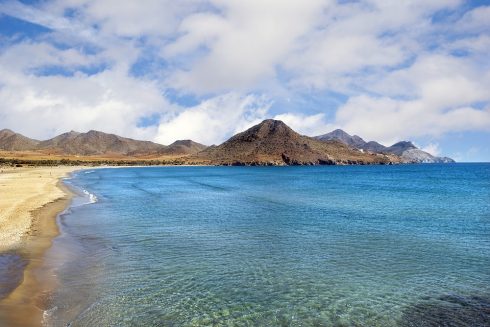
Fears for biodiversity and sea life after waters in Spain’s Andalucia record high temperature
More from the olive press.

- Newsletters
Signs of strength in Spain’s tourism industry
Tourism ended this year’s summer season in great shape with international tourist arrivals coming very close to the records set in 2019, a year that was extremely positive for the industry. Domestic tourism has also continued to post very good figures. However, the macroeconomic scenario represents a risk for the trend in tourism activity over the coming quarters due to high inflation and the economic slowdown in Europe. Nevertheless, we believe that tourism demand still enjoys significant levers for growth in the coming year and we therefore expect the sector to complete its recovery in 2023.

The situation in the tourism industry has altered dramatically. After an extremely difficult 2020 and a 2021 in which the recovery was far from satisfactory, 2022 has categorically confirmed that the sector continues to be a driver of growth for the Spanish economy. Official business indicators published by Spain’s National Statistics Institute (INE) point to the fact that, this summer, real tourism demand (without the price effect) was very close to the figure recorded in the same period of 2019. Total overnight stays in hotel and non-hotel accommodation during the months of July, August and September were just 1.3% below those of summer 2019. These good figures were further cemented by dynamic domestic tourism, whose volume of overnight stays was 6.6% higher than in 2019. However, this figure was slightly down on the one posted in the summer of 2021, probably due to an increase in trips abroad thanks to the recovery in international travel. For its part, international tourism performed much better than in 2021, reaching a level of overnight stays just 5.9% lower than in 2019.
Tourist overnight stays
If we look at which countries lie behind this strong recovery in international tourist arrivals in recent months, we can see some interesting trends. Based on passenger data for flights operated in Spain (see the table below), we note that improvements in tourist arrivals from the EU have been key. The figures are still 9% below those of 2019 (coming from –42% in 2021), mainly due to the saturation problems experienced at northern European airports. 1 The impact of this saturation can be seen most clearly in UK passenger arrivals which, in the summer, were 14% below those of the same period in 2019. The situation appeared somewhat similar for arrivals from Germany, with numbers still 15% lower, but this was not the case for arrivals from countries with less saturation, such as France and Portugal. It should be noted that the sharp drop in the number of passengers from countries under the «Rest of Europe» heading since Q2 2022 reflect the cutting of air connections with Russia since the start of the war in Ukraine, although this decline is not noticeable in the overall figure due to its small relative weight.
On the other hand, 2022 has also been a turning point for long-haul tourism. After the extremely low number of arrivals in 2021, the most recent figures for 2022 are highly positive for tourism from the Americas, and particularly from Latin America. We therefore anticipate that, looking ahead to 2023, the recovery in non-European international arrivals will be one of the key levers of growth. This will also mean the return of the emerging markets prior to the pandemic, which were the ones offering the greatest growth potential for some Spanish tourist destinations.
- 1. See the article «Europe’s saturated airports: a brake on the summer’s recovery», in this Sector Report.

This good performance by tourism demand is surprising because of two factors: it has been achieved in an environment of sharp price rises and also a loss of purchasing power among consumers throughout the EU. Tourism prices were no exception, reaching record highs during the last summer season . Consequently, for the time being it seems that the tourism sector has been able to raise its prices without too much impact on demand.
Although tourism prices have responded to the rise in production costs, according to our analysis the increase seen in prices has been mainly due to the strong recovery in international demand which, together with domestic demand, filled the market in many Spanish tourist destinations. This has been the case in the hotel sector, achieving occupancy rates above 80% in a third of the more than 100 tourist municipalities analysed by Spain’s National Statistics Institute in its hotel occupancy survey. CPI accommodation prices were more than 17% higher than those recorded in summer 2019 and this situation can also be seen in other prices related to tourism, such as hospitality and air travel, as shown in the chart below.
Trend in tourism-related prices of the CPI
Looking ahead to the next few months, the indicators for interest in travelling to Spain we produce based on Google search results have remained dynamic, albeit somewhat less «euphoric» for European tourism. The interest indicator places searches from the United Kingdom and EU within the benchmark range, 2 which is very good news given the economic situation in Europe, especially in the United Kingdom with sharp increases in inflation and an economic slowdown, in addition to the depreciation of the pound for British tourists. Given this situation, one would expect a decline in interest in travel from European countries, something which is not being observed, however.
Also noteworthy is the fact that interest in travelling to Spain seems to have returned to normal in the US market since March and, more recently, the interest of Japanese tourists appears to be picking up , after remaining at very depressed levels until last June. This is highly relevant since it suggests that two of the most important outbound markets (USA and Canada, Japan and Korea) that generated the most growth in the tourism sector before the pandemic, in the absence of the Chinese market, might recover throughout the course of 2023.
- 2. The benchmark range is constructed from searches recorded between 2017 and 2019.
The data point to recovery throughout the course of 2023 in two of the fastest growing pre-pandemic outbound markets (USA and Canada, Japan and Korea)
Weekly searches in Google for trips to Spain
The current scenario is difficult to interpret: It looks very positive judging by the recent trend in all indicators, both official and internal and also high-frequency, but negative due to the macroeconomic outlook of the outbound countries. Nevertheless, our forecast for 2023 remains positive, supported by the levers for growth we continue to see for the sector and tourism demand’s limited exposure to the macroeconomy.
- Improved air travel in northern Europe: tourist arrivals from northern Europe were trapped by a growth ceiling due to airport saturation in the summer (the figures for the United Kingdom and Germany, for instance, are about 20% below their pre-COVID air travel level). This situation should adjust in the coming quarters and could lead to a considerable improvement in international travel by European tourists. 3
- High potential and great room for improvement in long-haul tourism: indicators point to the improving trend in long-haul tourism continuing over next few quarters. The room for improvement is still significant, with US tourist arrivals 20% below their pre-COVID levels and Korean and Japanese tourist arrivals more than 70% below.
- Low exposure to the macroeconomy: according to the sensitivity analysis we carried out in order to understand how declines in economic activity in outbound markets correlate with declines in tourism demand for Spain, we estimate that the tourism sector has only limited exposure to the economic slowdown in Europe. Specifically, we estimate that the drop in economic activity in the United Kingdom (GDP is expected to fall by 1.3% in 2023) will impact annual growth in British overnight stays by –2.9 percentage points. For Germany (GDP is expected to fall by 0.2% in 2023), we estimate an impact of –2.2 percentage points of growth in overnight stays. 4 These impacts, which are certainly appreciable, are nevertheless relatively small compared with the margin for growth enjoyed by both the United Kingdom and Germany thanks to the improvement in airport saturation.
Taking all this into account, our tourism GDP forecast for 2022 stands at 98% of its 2019 level ; i.e. just 2% below its pre-COVID level and 66% above the figure for 2021. It should be noted that we expect the sector’s dynamism to be somewhat weaker in Q4 this year as the economic difficulties faced by the EU are felt, albeit to a limited extent. However, we expect tourism activity to pick up strongly from Q2 2023 onwards, as well as some improvement in the economic tone of the EU, so we have placed our tourism GDP forecast 2% above the 2019 level of activity for the whole of next year .
- 3. See the article «Europe’s saturated airports: a brake on the summer’s recovery», in this Sector Report.
- 4. For each outbound country, we have estimated the linear sensitivity of the growth rate in hotel overnight stays to the year-on-year growth in that country’s GDP. To calculate the impact of our macroeconomic scenario on growth in tourism demand, we use the difference between our most recent growth forecast for each country and that of our counterfactual scenario (we have used our February 2022 scenario, prepared before the outbreak of the war in Ukraine).
Our tourism GDP forecast for 2022 is just 2% below its pre-COVID level and 66% above the figure for 2021.
Tourism GPD
Although the outlook is positive, we can only repeat the mantra that we are currently going through a time of great economic uncertainty. In the case of the tourism sector, the main source of uncertainty is related to costs , so managers of tourism firms will have to be vigilant in order to tackle any possible deviation from what has been budgeted for 2023. For the time being, the upturn in costs in 2022 is being handled without any major tensions in the sector as a whole, thanks to the significant increases in tourism prices we have seen. This has been very effective in combating the rising energy costs (which have more than doubled compared with the previous year), the cost of agrifood products (whose prices rose by 12% year-on-year in September) and renovation costs (with construction materials 16% more expensive than a year ago at the end of July).
Looking ahead to 2023, we expect production costs to remain high and, in some cases, to continue rising. There is also the potential impact from wage increases which, although they are expected to be contained, are the main cost for tourism businesses (on average, companies in the sector spend 21% of their revenue on wages), as can be seen in the next chart. As a result, if the sector wants to go on defending its margins, it will be forced to continue to raise prices.
The upturn in costs in 2022 is being handled without any major tensions in the sector as a whole, thanks to the significant increases in tourism prices we have seen.

To read below

Snapshot of the catering sector in Spain: from bars to Michelin stars

How has international tourism demand changed since the pandemic?

Tourist loyalty and climate change

How Climate Change Impacts Tourism in Spain

Maria Perez
Climate change is one of the greatest global challenges of our time, and its impact on tourism, especially in a country like Spain, cannot be underestimated. As one of the world’s most popular tourist destinations, Spain faces significant changes in its tourism sector due to rising temperatures, extreme weather events, and climate variability. This article explores how climate change is affecting tourism in Spain, from seasonal demand to adaptation strategies within the industry.
Climate Change and Tourist Demand in Spain
Climate change is profoundly and complexly altering tourist demand patterns in Spain. Warmer temperatures are influencing tourists’ preferences, as well as the destinations and activities they choose.
The Effect of Rising Temperatures on Tourist Seasons
Rising temperatures are causing tourist seasons to lengthen or shift. For example, regions traditionally more visited during the summer months, such as the Costa del Sol and the Balearic Islands, are seeing an increase in the number of visitors during spring and autumn. This change can have advantages, such as reducing peak season saturation and distributing tourism more evenly throughout the year. However, it also presents challenges, such as adapting infrastructure and managing resources.

Changes in Tourist Preferences
As temperatures rise, some tourists may begin to avoid hotter destinations during peak heat periods, instead seeking cooler destinations or activities that involve less heat exposure. This could benefit northern regions of Spain, such as Galicia or the Basque Country, which offer milder climates during the summer. However, destinations that rely on sun-and-beach tourism may experience a decrease in demand during the hottest months.
Impact on Tourist Activities and Infrastructure
The effects of climate change are not limited to temperatures; they also affect tourist activities and the infrastructure that supports them.
The Challenge of Extreme Weather Events
The increase in the frequency and intensity of extreme weather events, such as storms, floods, and heatwaves, is affecting tourist infrastructures and the overall visitor experience. For example, floods can damage hotels and roads, while heatwaves can make some outdoor activities dangerous or unpleasant.
Adaptation of Tourist Infrastructure
To face these challenges, tourism businesses and destinations in Spain are beginning to invest in more climate-resilient infrastructure. This includes building hotels and resorts that can withstand extreme weather events, as well as creating early warning systems and evacuation plans to ensure tourist safety.
Recent Trends and Adaptation to Climate Change
Tourism in Spain is adapting to the new challenges posed by climate change by adopting more sustainable practices and developing new strategies to cope with changing realities. These trends not only respond to climate challenges but also open opportunities for more responsible and conscious tourism that can help preserve Spain’s natural and cultural environment.
Sustainable and Ecological Tourism
One of the most notable trends in adapting tourism to climate change is the rise of sustainable and ecological tourism. This trend is driven by a shift in traveler mentality, with more tourists becoming aware of the environmental impact of their travel decisions. As a result, they seek options that minimize their carbon footprint and promote sustainability.
Sustainable tourism is not limited to choosing eco-friendly accommodations or preferring less polluting means of transport, such as trains instead of planes. It also includes a greater demand for activities that have a positive or neutral impact on the environment. For example, ecotourism, which involves visits to natural areas to enjoy and appreciate nature in a way that conserves the environment and promotes sustainable local development.
Additionally, rural tourism has gained popularity, offering travelers the opportunity to connect more directly with nature and local communities. This type of tourism encourages sustainable agricultural practices, such as permaculture and agroecology, and supports local producers, contributing to the local economy in a sustainable way.
The positive impact of these forms of tourism goes beyond reducing emissions. They help raise awareness about the importance of protecting natural and cultural resources and encourage greater respect for the environment . This, in turn, can influence tourists to adopt more sustainable habits in their daily lives.

Innovation in Resource Management
Technological innovation and efficient resource management are crucial for the tourism sector in Spain to adapt to climate change. This innovation aims not only to reduce the environmental impact of tourism but also to improve the resilience of destinations to the effects of climate change, such as rising temperatures and extreme weather events.
One key area of innovation is water management, especially in regions suffering from water stress, such as the Balearic Islands and southeastern Spain. Many hotels and resorts are investing in water-saving technologies, such as greywater reuse systems and the installation of low-flow devices in showers and faucets. For example, some resorts on the Costa del Sol have implemented rainwater collection systems for garden irrigation, thus reducing their dependence on potable water.
In terms of energy, the transition to renewable sources is gaining momentum. Some hotels are installing solar panels and using geothermal heating and cooling systems to reduce their consumption of non-renewable energy. Additionally, green building technologies, such as thermal insulation materials and passive ventilation systems, are being adopted to help maintain comfortable temperatures without intensive air conditioning, thereby reducing greenhouse gas emissions.
Another significant innovation is the use of digital technology to improve operational efficiency and reduce waste. Mobile apps that allow tourists to plan more efficient routes, avoiding peak hours and crowded destinations, contribute to a more enjoyable and sustainable experience. Furthermore, using artificial intelligence and big data to predict tourist demand can help businesses optimize their resources and minimize their environmental impact.
The Future of Tourism in Spain in the Context of Climate Change
As climate change continues to affect the tourism sector, it is essential for Spain to develop long-term strategies to adapt and thrive in this new context. This involves not only mitigating negative impacts but also taking advantage of opportunities arising from increased environmental awareness and the demand for sustainable practices.
Policies and Adaptation Strategies
Spanish authorities, in collaboration with tourism organizations, are implementing policies and strategies designed to mitigate the effects of climate change on tourism. A key approach is promoting off-season tourism, which not only helps reduce pressure on destinations during peak months but also extends the economic benefits of tourism throughout the year.
Diversifying the tourism offer is another important strategy. Promoting a variety of tourist experiences, from gastronomic tourism and wine tourism to adventure and cultural tourism, can attract different types of travelers and distribute demand more equitably. In this regard, creating themed routes that connect different regions and attract tourists interested in specific themes, such as modernist architecture or medieval history, can be an effective way to diversify the offer and promote tourism in less-visited areas.
Collaboration and Shared Responsibility
Adapting to climate change in the tourism sector requires close collaboration among multiple stakeholders, each playing a crucial role in creating more sustainable and resilient tourism.
Governments can establish regulatory frameworks that promote sustainability, such as regulations that encourage energy efficiency and the use of renewable resources in the hotel sector. They can also facilitate research and development of innovative technologies to help mitigate the effects of climate change.
Tourism companies, for their part, have the responsibility to implement sustainable practices in their operations and educate their customers about the importance of sustainability. This can include everything from recycling programs and waste reduction to offering tourist experiences that promote respect for the environment and local cultures.
Finally, tourists also play a fundamental role. As awareness of climate change grows, travelers must make informed and responsible decisions that support sustainable practices. This could mean choosing less crowded destinations, opting for less polluting transportation, or participating in activities that positively impact local communities.
Climate change presents both challenges and opportunities for the tourism sector in Spain. While some destinations may face decreases in demand or the need to adapt to extreme weather events, others may benefit from extended seasons and increased interest in sustainable tourism. It is essential for both authorities and businesses in the sector to prepare for these changes by adopting adaptation and sustainability strategies that ensure a resilient future for tourism in Spain.
Related news

Which EU Regions Have the Most Online Reservations in 2024?
Aug 22, 2024
The dynamics of European tourism have drastically changed in 2024. Travelers' preferences, driven by technology and shifts in consumption patterns, have led to a boom in certain regions of the European Union (EU). Andalusia, a jewel in southern Spain, stands out as a...

The Impact of Influencers on Tourism
Aug 12, 2024
Tourism has changed drastically in recent years, largely due to the influence of social media and influencers. From exotic locations to local destinations, an influencer’s recommendation can transform an unknown spot into a must-see for travelers worldwide. But what...
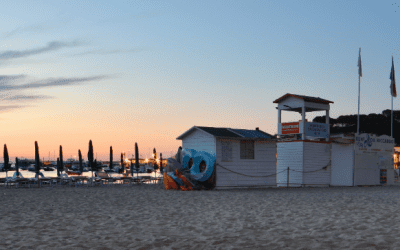

Smart Beaches: The New Commitment to Sustainable Tourism
Aug 2, 2024
Sun and beach tourism has been one of the main travel motivations worldwide. However, growing concerns about environmental impact and the need to manage resources more efficiently have driven the adoption of innovative technologies in these destinations. In this...
Stay in The Know: Subscribe to Smartvel Blog
Other links
- e-Office portal
- Attention to citizens
- Registry Assistance Office
Statistics and Reports
- Recommend on Facebook
- Send by mail
- Movimientos Turísticos de Españoles (FAMILITUR)
- Movimientos Turísticos en Fronteras (FRONTUR) - DATAESTUR
- Encuesta de Gasto Turístico (EGATUR) - DATAESTUR
- Estadísticas de hostelería y turismo
- Campamentos Turísticos
- Establecimientos hoteleros
- Apartamentos Turísticos Autorizados
- Turismo Rural
Has this page helped you?
- Yes esta pagina es util
- No esta pagina no sirve
Thanks for your comments.
- The Biggest Industries In Spain

The economy of Spain is among the largest in the world, with its Gross Domestic Product standing at $1.36 trillion. The country ranks at 14th place in the world’s largest economies. In Europe, Spain’s GDP is only surpassed by that of France, Italy, Germany, and the UK. Despite being hit by the 2007-2008 financial crisis and the property recession of the 2000s, the economy has experienced significant growth in recent years, growing by 3% in 2016. However, the country is heavily indebted, with public debt being equivalent to 99% of Spain’s GDP. In 2013, the country’s gross external debt stood at $1.3 trillion. The euro is the official currency used in the country. The regulation of financial institutions is handled by the Banco de Espana, the nation’s central bank. The country has invested heavily in infrastructure to facilitate the growth of industries in the country. Spain is home to the fifth-busiest port in Europe; Valencia which is also the busiest port in the Mediterranean. The country has Europe’s longest high-speed rail network and is only surpassed globally by China. The major industries that drive the economy of Spain are the tourism, manufacturing, agriculture, and energy industries.
The tourism industry is an important economic driver in the country, accounting for about 11% of the nation’s annual GDP. As the world’s third-most popular tourist destination, Spain receives more than 75 million tourists each year, who come to sample its wide range of attractions. The prominence of Spain in the global tourism industry is manifested with the presence of the headquarters of the World Tourism Organization. Tourists from France, the United Kingdom, Germany, and Italy make up the bulk of Spain’s international tourists. The country has a total of 12 national parks, the majority of which are found in the country’s mainland. Spain is marketed as the ideal summer holiday destination in Europe and has numerous attractions to that effect. The island of Tenerife is Spain’s most visited tourist site, as it is home to the famed Teide National Park, the most famous national park in the country. The Mediterranean coast features fantastic beaches, which attract summer tourists in their millions. On the other end of the spectrum is Sierra Nevada, the country’s number-one winter tourism destination, and home to many ski resorts. Spain is not only known for its natural beauty but also its historical sites. The country is home to the third-most important city in Catholicism; Santiago de Compostela, which draws Catholic pilgrims from around the globe.
Manufacturing
Pharmaceuticals and automobiles are the primary export commodities from Spain’s manufacturing industry. The pharmaceutical market in the country is valued at an estimated $25 billion. The automobile sector is among Spain’s primary economic drivers. With an annual vehicle production of more than 2.8 million units, the country is Europe’s second-largest automobile manufacturer, and eight-largest in the world. As much as 80% of the vehicles manufactured in Spain are destined for export. The sector accounts for about 19% of Spain’s annual exports and about 9% of the GDP. Spain is home to 13 automobile manufacturing establishments, with PSA and SEAT being the country’s two largest automobile producers. Many global automobile-manufacturing giants have operations in Spain, and these include Daimler AG, Ford, General Motors, Renault, and Nissan.
Agriculture
Agricultural production in the country is limited by the poor soils, with only 10% of the land area in Spain being considered excellent for cultivation. The country’s terrain also hinders the implementation of new technologies in the industry. Nonetheless, Spain still has Europe’s second-largest land devoted to agricultural purposes, with the country’s agricultural land only exceeded in size by France. The majority of the agricultural land is used as pastureland. Land under irrigation-based agriculture in Spain accounts for only 17% of the country’s cultivated land, but produce as much as 50% of Spain’s agricultural exports. Horticultural products are Spain’s most important agricultural export commodities, and these include vegetables and citrus fruits. The country produces the highest amount of olives in the world and is Western Europe’s top producer of citrus fruits. Despite having the largest area of vineyards in the world, and being the world’s number-one wine exporter, the wine produced in Spain does not stand out and is often bottled in neighboring France and Italy from where it is sold. Essential livestock products in Spain include pork, beef, milk, and poultry.
Energy And Electricity
Another critical industry in Spain is the country’s energy industry. The country is heavily reliant on fossil fuels in its energy consumption. Of the energy consumed in Spain, 42% is sourced from oil, 19.8% from natural gas, and 11% from coal. The country has to source most of the fossil fuels from external markets, as the country has few proven oil reserves while its coal is of poor quality. The major oil field in the country is the Ayoluengo oil field, which has an estimated 104 million barrels of proven oil reserves. The country’s lack of energy resources is often mentioned as the main hindrance to Spain’s economic growth. The total electricity produced annually in Spain is more than 276.8 TWh, the majority of which is consumed locally. Only 3% of the electricity produced is exported. Renewable sources such as nuclear, hydropower, geothermal, wind and solar are important in electricity generation, as a result of Spain’s heavy investment in the sector. The country’s investment in solar power generation is particularly huge, with Spain having the world’s largest solar industry. Spain also made history for being the pioneering country to have wind power as its primary energy source for a whole year in 2013. A Spanish company, Iberdrola, is recognized as the largest renewable energy producing company in the world.
Exports And Imports
France, Germany, and Italy are the top markets for Spain’s exports, accounting for about 16%, 11% and 7% of the country’s total exports respectively. The primary export commodities from Spain are pharmaceuticals, agricultural goods such as wine and citrus fruits, and automobiles. Consumer goods, fossil fuels, machinery, and chemicals are Spain’s main import items, most of which are sourced from Germany, France, and China.
More in Economics
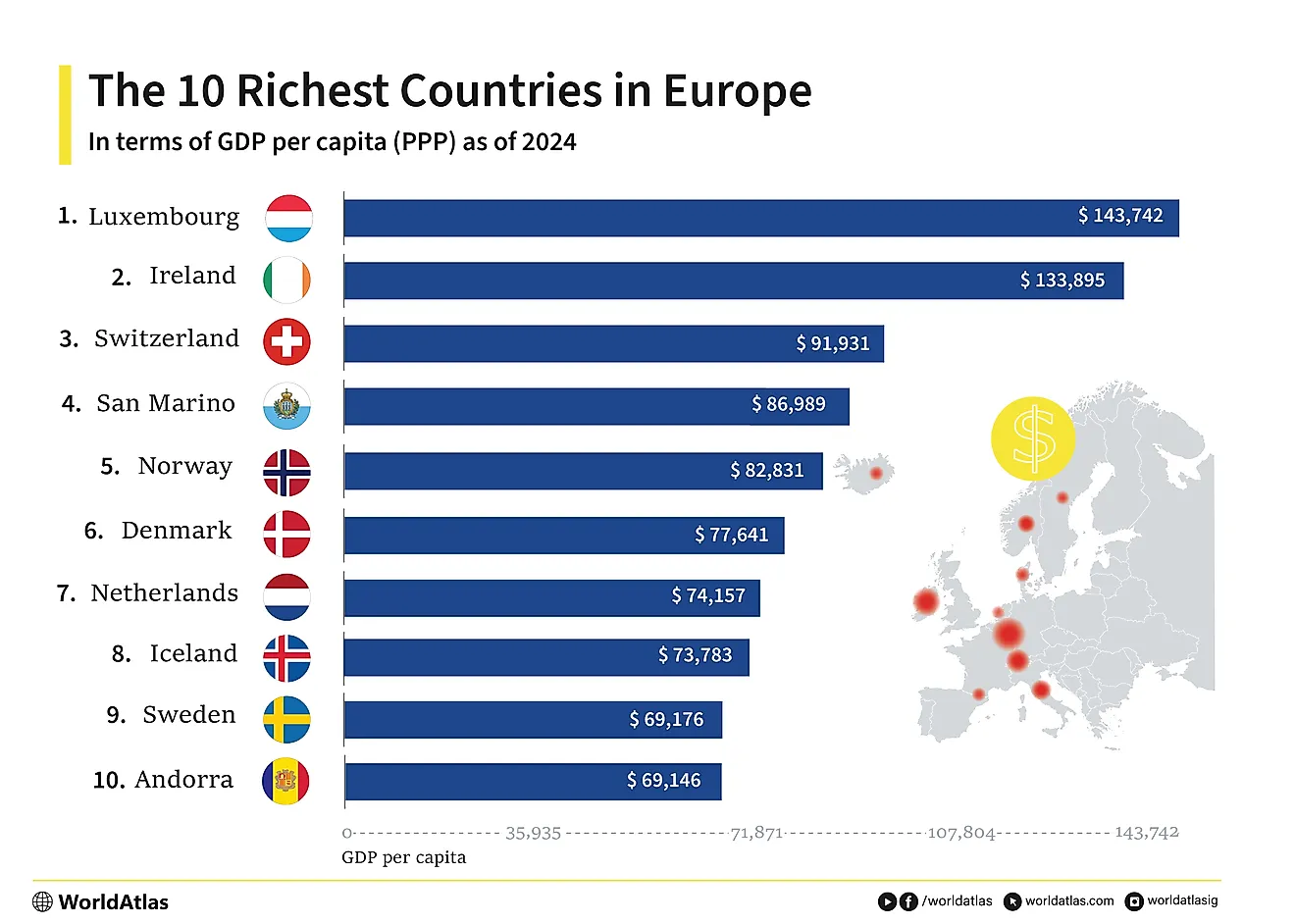
The Richest Countries In Europe

The 10 Largest Iron Ore Mines in the World
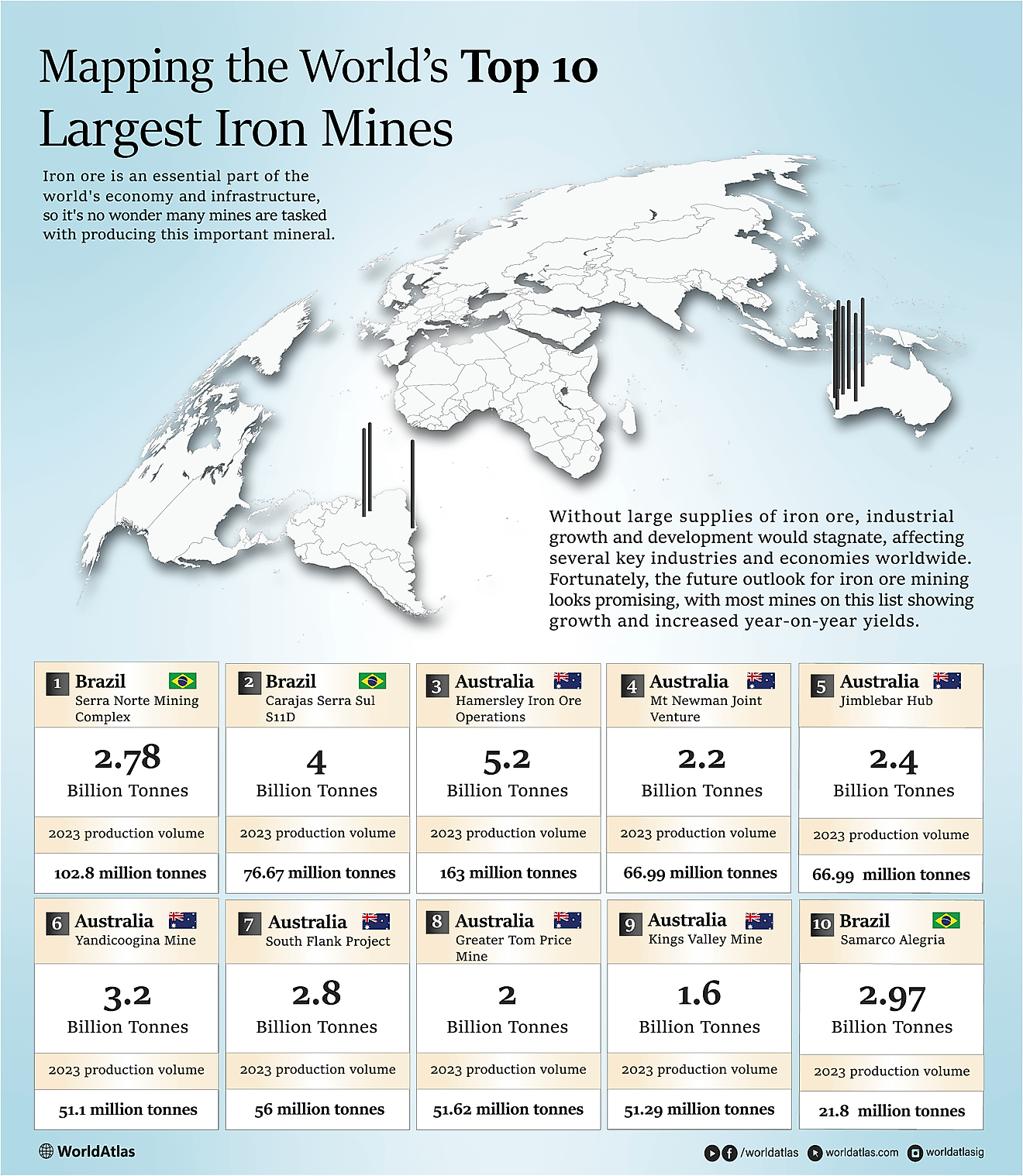
The 10 Largest Iron Mines In The World

The Richest Landlocked Countries In The World

The 10 Largest Potash Producing Countries in the World

The 10 Largest Coal Mines in the World
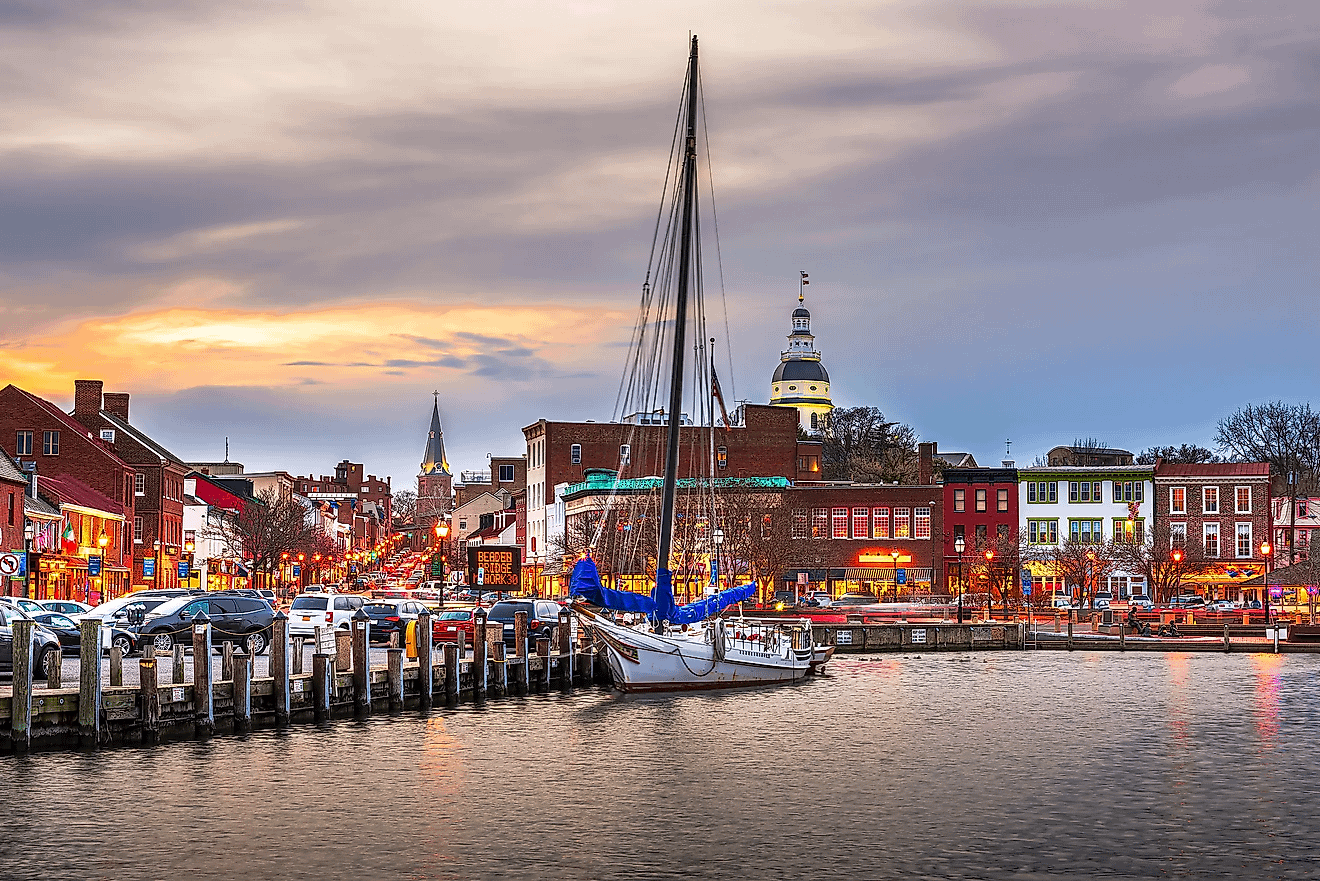
10 Richest US States
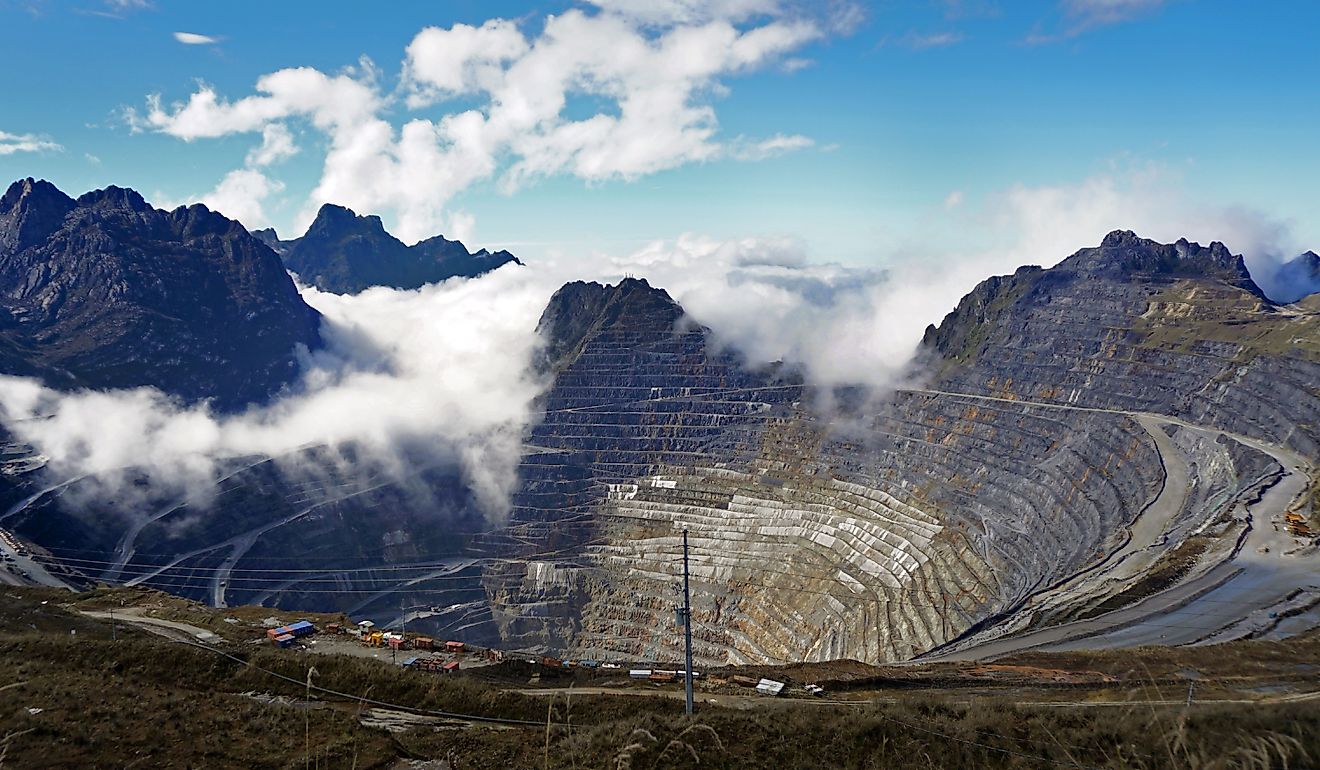
The 10 Largest Copper Mines in the World
- Today's news
- Reviews and deals
- Climate change
- 2024 election
- Newsletters
- Fall allergies
- Health news
- Mental health
- Sexual health
- Family health
- So mini ways
- Unapologetically
- Buying guides
- Labor Day sales
Entertainment
- How to Watch
- My watchlist
- Stock market
- Biden economy
- Personal finance
- Stocks: most active
- Stocks: gainers
- Stocks: losers
- Trending tickers
- World indices
- US Treasury bonds
- Top mutual funds
- Highest open interest
- Highest implied volatility
- Currency converter
- Basic materials
- Communication services
- Consumer cyclical
- Consumer defensive
- Financial services
- Industrials
- Real estate
- Mutual funds
- Credit cards
- Balance transfer cards
- Cash back cards
- Rewards cards
- Travel cards
- Online checking
- High-yield savings
- Money market
- Home equity loan
- Personal loans
- Student loans
- Options pit
- Fantasy football
- Pro Pick 'Em
- College Pick 'Em
- Fantasy baseball
- Fantasy hockey
- Fantasy basketball
- Download the app
- Daily fantasy
- Scores and schedules
- GameChannel
- World Baseball Classic
- Premier League
- CONCACAF League
- Champions League
- Motorsports
- Horse racing
New on Yahoo
- Privacy Dashboard
Italy weighs steep tourist tax as European backlash against visitors grows
Italy is weighing a steep increase in tourist taxes to counter the impact of overtourism, the latest European country to take steps against unmanageable visitor numbers that have led to protests across the continent.
Under the proposed measure, the tax to spend the night in an Italian city, currently €1-€5 ($1-$5.50), could increase to up to €25 for the most expensive hotel rooms, the Financial Times reported — with the country’s Tourism Minister saying it would make tourists “ more responsible .”
Europe has become the epicenter of a movement against mass tourism this summer, with protests erupting in several countries including Spain, the Netherlands, and Greece, as residents object to the negative impact excessive visitor numbers have on their quality of life.
Residents protest rising costs and changing neighborhoods
Chief among residents’ complaints about an overflow in visitors is the rise in the cost of living and gentrification seen in highly popular tourist areas, which has pushed some residents out. In Barcelona, for example, rents have risen 68% in the past decade, CNN noted. Many feel tourism ruptures the social fabric of certain neighborhoods in touristy cities, where historic establishments are often forced out to make room for shops selling cheaper, lower-quality products aimed at visitors, Italian outlet Il Post added. Overtourism adds to the pressure on health services, waste management, and water supplies, Euronews reported, while the construction of hotels and new housing can bring environmental concerns.
In Italy, a fine line between preserving industry and protecting residents
In Italy, many residents are irked at the impact tourism has on their cities and support an increase in taxes for visitors, the Financial Times reported. But the government is also wary of alienating the tourism industry, which accounted for about 6% of the country’s GDP according to the most recent estimates , Italian outlet Pagella Politica noted. Some leaders in the tourism sector and politicians have already expressed frustration at the proposed measure, which they say may deter visitors and negatively impact the hospitality sector. Italy is also facing the pressure of increased public debt, which could reach 140% this year, the Financial Times added.
Past tourist taxes have produced mixed results
A number of popular tourist destinations in Europe have recently introduced or increased their tourist taxes, National Geographic reported, but the levies have produced mixed results . In Barcelona, two fees — one of which has increased from €0.75 ($0.80) per night in 2021 to €3.25 in 2024 — haven’t deterred tourists from visiting the city, but the city council expects to collect over $100 million from them in 2024, which officials say will help increase residents’ quality of life. In Amsterdam, a high tourist tax may just push visitors to spend the night outside the city and commute in for the day, one university professor told the magazine — which wouldn’t reduce the number of tourists, but would slash the revenue locals can make from accommodation.
Recommended Stories
Savings interest rates today, september 2, 2024 (earn up to 5.50% apy).
Compare the best savings interest rates available today vs. the national average.
Watch: USC WR Kyron Hudson makes incredible one-handed catch in win over LSU
Hudson's catch set up USC's first TD of the game.
US Open: Emma Navarro hangs on to beat defending champion Coco Gauff, reach quarterfinals
Emma Navarro has now beaten Coco Gauff two straight times after her victory at Wimbledon earlier this summer.
Bodies of 6 Israeli hostages recovered in Gaza, prompting protests and renewed calls for ceasefire
Six people are dead. Their families are demanding answers.
The case against AI art
No matter who powerful generative AI becomes, writer Ted Chiang says it will never create true art. Chiang is one of the most admired science fiction authors writing today, best known for the novella “Story Of Your Life” (which was adapted into the movie “Arrival”).
Junkyard Gem: 1976 Volvo 244 DL
A 1976 Volvo 240 sedan with automatic transmission and air conditioning, found in a Colorado wrecking yard.
Smile! Oprah's favorite electric toothbrush is a sparkling $20 for Labor Day
The top-rated Sonicare is travel-ready and comes with a timer to make sure you give your pearly whites their due.
'I named it Jeeves': Pet owners adore this quiet robovac, and it's over 50% off
'All I can say is wow,' wrote a reviewer with multiple dogs — get this beast for just $90(!) while you can.
Palantir’s CTO, and 13th employee, has become a secret weapon for Valley defense tech startups
On August 5, Palantir’s CTO Shyam Sankar stood in front of about 20 nervous new employees at the company’s Washington, D.C. office and gave a speech you’d expect at a new hire meeting: company mission, Palantir’s history, etc. But there was one part that would’ve seemed unfathomable a few years ago: Sankar evangelized the importance of a new wave of defense tech startups, spun up by Palantir, Tesla and SpaceX alums. Any business Palantir gets from startups is dwarfed by its government contracts, after all. Palantir likes to remind the world that it’s not like other publicly traded companies, i.e.
The best Target Labor Day sales to shop right now: Deals on iPads, Vacuums, Air Fryers and more
These deals are on point: A $90 Ninja air fryer, $100 off iconic Sony headphones, patio furniture steals and a boatload more.
Ford recalls 90,736 vehicles due to engine valve issue
Ford will recall 90,736 vehicles as engine intake valves in the vehicles may break while driving, according to the National Highway Traffic Safety Administration.
These Labor Day mattress sales from Tempur-Pedic, Serta and more promise 40 winks and up to $1,200 off
The back-saving buys include $750 off a cooling Casper hybrid and a mere $245 for a foot-thick memory-foam queen from BedStory.
How about seeing off summer with a bang? We're spotlighting these all-time-low Labor Day deals
A MacBook Air for $800, a Roomba for just $180 and an iPad for $200 are just some of the standout steals
The best Labor Day sales happening now — shop our top picks from Amazon, Walmart and more
Our editors are scouting the biggest Labor Day deals in real time.
Mortgage and refinance rates today, September 1, 2024: Rates fell 20 points in August
These are today's mortgage and refinance rates. Mortgage rates are down overall since August 1, so it could be a good time to buy a home. Lock in your rate today.
How to wash a car
Washing your car is something you can do yourself and you can do a much better job with the proper tools and instructions than a standard machine auto wash.
Your September guide to healthy living: Book your COVID booster, eat apples and check out the harvest moon
Go apple picking, upgrade your breakfast and other items for your September to-do list.
Photos show Greece tourist port flooded with more than 100 tons of dead fish
Millions of dead fish stink up central Greece and strike a blow to tourism in a port city. Scientists link the mass die-off to climate change.
Shohei Ohtani, Mookie Betts and Freddie Freeman make Dodgers history with back-to-back-to-back HRs
Ohtani recorded his 44th homer of the season amid his push for an unprecedented 50-50 season.
49ers' Ricky Pearsall released from hospital after being shot in chest in San Francisco
Ricky Pearsall was shot during an alleged attempted robbery in San Francisco on Saturday afternoon.
Travel, Tourism & Hospitality
Industry-specific and extensively researched technical data (partially from exclusive partnerships). A paid subscription is required for full access.
- Tourism sector as share of GDP in Spain 2010-2021
Contribution of tourism to gross domestic product in Spain from 2010 to 2021
To access all Premium Statistics, you need a paid Statista Account
- Immediate access to all statistics
- Incl. source references
- Download as PDF, XLS, PNG and PPT
Additional Information
Show sources information Show publisher information Use Ask Statista Research Service
December 2022
2010 to 2021
¹Provisional. ²Estimates. Data prior to 2015 was retrieved from previous releases.
Other statistics on the topic Travel and tourism in Spain
- Inbound tourism volume in Spain 2023, by origin
- Tourism contribution to Spanish GDP 2006-2023
- Most visited cities in Spain 2022
Leisure Travel
- Pilgrims on the Way of Saint James 2011-2023

To download this statistic in XLS format you need a Statista Account
To download this statistic in PNG format you need a Statista Account
To download this statistic in PDF format you need a Statista Account
To download this statistic in PPT format you need a Statista Account
As a Premium user you get access to the detailed source references and background information about this statistic.
As a Premium user you get access to background information and details about the release of this statistic.
As soon as this statistic is updated, you will immediately be notified via e-mail.
… to incorporate the statistic into your presentation at any time.
You need at least a Starter Account to use this feature.
- Immediate access to statistics, forecasts & reports
- Usage and publication rights
- Download in various formats
* For commercial use only
Basic Account
- Free Statistics
Starter Account
- Premium Statistics
The statistic on this page is a Premium Statistic and is included in this account.
Professional Account
- Free + Premium Statistics
- Market Insights
1 All prices do not include sales tax. The account requires an annual contract and will renew after one year to the regular list price.
Statistics on " Travel and tourism in Spain "
- Leading European countries in the Travel & Tourism Development Index 2023
- Monthly growth rate of tourism GDP in Spain 2022
- Tourism employment in Spain 2015-2021
- Tourism employment in Spain Q4 2022, by industry
- Inbound visitors in Spain 2000-2023
- International tourism spending in Spain 2012-2022
- Domestic trips in Spain 2015-2022
- Domestic trips in Spain 2023, by destination
- Domestic tourism spending in Spain 2015-2022
- Share of travel and tourism spending in Spain 2022, by traveler origin
- Inbound tourism volume in Spain 2023, by travel reason
- Domestic trips in Spain 2022, by travel reason
- Share of travel and tourism spending in Spain 2022, by purpose
- Inbound trips for cultural purposes to Spain 2010-2022
- Number of enotourists in Spain 2008-2023
- Number of skiers and snowboarders in Spain 2010-2022
- Tourism premises in Spain 2015-2021
- Share of tourism companies in Spain 2021, by size
- Main hotel groups in Spain FY2021, by sales revenue
- Main passenger airlines in Spain 2022
- Main travel agencies in Spain FY2021, by sales revenue
- Main restaurants and food stall companies in Spain FY2022, by sales revenue
- Ecotourism businesses' average revenue in Spain 2022, by type
- Main coastal destinations in Spain 2022, by number of hotel guests
- Attendance to Spanish National Heritage sites 2022
- Attendance to Spanish national parks 2022
- Cruise ship calls at Spanish ports 2022, by authority
- Enotourism destination areas in Spain 2023, by region
- Quarterly online revenue of accommodation businesses in Spain 2014-2022
- Quarterly online revenue of travel agencies & tours operators in Spain 2014-2022
- Airbnb revenue in Spain 2015-2020
- Willingness to purchase tourism services online in Spain 2019-2022
- Average spend on tourism services booked online in Spain 2018-2022
- Hotel / private accommodation online bookings by brand in Spain 2024
Other statistics that may interest you Travel and tourism in Spain
- Premium Statistic Leading European countries in the Travel & Tourism Development Index 2023
- Premium Statistic Tourism contribution to Spanish GDP 2006-2023
- Premium Statistic Tourism sector as share of GDP in Spain 2010-2021
- Premium Statistic Monthly growth rate of tourism GDP in Spain 2022
- Premium Statistic Tourism employment in Spain 2015-2021
- Premium Statistic Tourism employment in Spain Q4 2022, by industry
Tourism volume and expenditures
- Premium Statistic Inbound visitors in Spain 2000-2023
- Premium Statistic Inbound tourism volume in Spain 2023, by origin
- Premium Statistic International tourism spending in Spain 2012-2022
- Premium Statistic Domestic trips in Spain 2015-2022
- Premium Statistic Domestic trips in Spain 2023, by destination
- Premium Statistic Domestic tourism spending in Spain 2015-2022
- Basic Statistic Share of travel and tourism spending in Spain 2022, by traveler origin
- Premium Statistic Inbound tourism volume in Spain 2023, by travel reason
- Premium Statistic Domestic trips in Spain 2022, by travel reason
- Basic Statistic Share of travel and tourism spending in Spain 2022, by purpose
- Premium Statistic Inbound trips for cultural purposes to Spain 2010-2022
- Premium Statistic Number of enotourists in Spain 2008-2023
- Premium Statistic Number of skiers and snowboarders in Spain 2010-2022
- Premium Statistic Pilgrims on the Way of Saint James 2011-2023
- Premium Statistic Tourism premises in Spain 2015-2021
- Premium Statistic Share of tourism companies in Spain 2021, by size
- Premium Statistic Main hotel groups in Spain FY2021, by sales revenue
- Premium Statistic Main passenger airlines in Spain 2022
- Premium Statistic Main travel agencies in Spain FY2021, by sales revenue
- Premium Statistic Main restaurants and food stall companies in Spain FY2022, by sales revenue
- Premium Statistic Ecotourism businesses' average revenue in Spain 2022, by type
Main destinations
- Premium Statistic Main coastal destinations in Spain 2022, by number of hotel guests
- Premium Statistic Most visited cities in Spain 2022
- Premium Statistic Attendance to Spanish National Heritage sites 2022
- Premium Statistic Attendance to Spanish national parks 2022
- Premium Statistic Cruise ship calls at Spanish ports 2022, by authority
- Premium Statistic Enotourism destination areas in Spain 2023, by region
Online travel market
- Premium Statistic Quarterly online revenue of accommodation businesses in Spain 2014-2022
- Premium Statistic Quarterly online revenue of travel agencies & tours operators in Spain 2014-2022
- Premium Statistic Airbnb revenue in Spain 2015-2020
- Premium Statistic Willingness to purchase tourism services online in Spain 2019-2022
- Premium Statistic Average spend on tourism services booked online in Spain 2018-2022
- Premium Statistic Hotel / private accommodation online bookings by brand in Spain 2024
Further related statistics
- Basic Statistic Travel and tourism's contribution to GDP in Denmark 2017, by type
- Basic Statistic Travel and tourism's direct contribution to GDP in Poland 2012-2028
- Basic Statistic Travel and tourism's total contribution to GDP in Croatia 2012-2028
- Basic Statistic Travel and tourism's total contribution to GDP in Finland 2012-2028
- Basic Statistic Travel and tourism's contribution to GDP in Norway 2017, by type
- Basic Statistic Travel and tourism's contribution to GDP in Sweden 2017, by type
- Basic Statistic Travel and tourism's total contribution to GDP in Hungary 2012-2028
- Basic Statistic Travel and tourism's direct contribution to GDP in Iceland 2012-2028
- Basic Statistic Travel and tourism's total contribution to GDP in Russia 2019-2034
- Premium Statistic Tourism share of GDP in Sweden 2015-2021
- Basic Statistic Travel and tourism's total contribution to GDP in Poland 2012-2028
- Basic Statistic Travel and tourism's direct contribution to GDP in Denmark 2012-2028
- Basic Statistic Total tourism contribution to GDP in Denmark 2019-2021
- Basic Statistic Travel & tourism: growth rate of purchases by tourism providers in the UK 2012-2028
- Premium Statistic Share of domestic and international tourism revenue in European destinations 2024
Further Content: You might find this interesting as well
- Travel and tourism's contribution to GDP in Denmark 2017, by type
- Travel and tourism's direct contribution to GDP in Poland 2012-2028
- Travel and tourism's total contribution to GDP in Croatia 2012-2028
- Travel and tourism's total contribution to GDP in Finland 2012-2028
- Travel and tourism's contribution to GDP in Norway 2017, by type
- Travel and tourism's contribution to GDP in Sweden 2017, by type
- Travel and tourism's total contribution to GDP in Hungary 2012-2028
- Travel and tourism's direct contribution to GDP in Iceland 2012-2028
- Travel and tourism's total contribution to GDP in Russia 2019-2034
- Tourism share of GDP in Sweden 2015-2021
- Travel and tourism's total contribution to GDP in Poland 2012-2028
- Travel and tourism's direct contribution to GDP in Denmark 2012-2028
- Total tourism contribution to GDP in Denmark 2019-2021
- Travel & tourism: growth rate of purchases by tourism providers in the UK 2012-2028
- Share of domestic and international tourism revenue in European destinations 2024

IMAGES
VIDEO
COMMENTS
Tourism sector in Spain - statistics & facts. Spain is an established tourism market in Europe - the region with the most tourist arrivals worldwide - and globally. In 2022, Spain registered ...
Spain has broken its record in number of international visitors: thanks to the more than 85 million tourists arriving in Spain, every year it is recognized as the second most visited country in the world, after France. The United States and Italy follow. Spain's success in the tourism industry is due especially to its rich cultural and natural attractions, but also to its exceptional ...
Tourism in Spain is a major contributor to national economic life, contributing to about 12.4% of Spain's GDP ... In early 2020, the country halted its tourism industry following the spread of COVID-19. Spain reopened to fully vaccinated travellers from around the world on 7 June 2021; however, due to the relatively late announcement of the ...
Pre-pandemic, Spain was the second-largest tourism destination in the world, drawing 84 million visitors in 2019 who brought over €92 billion in revenue. 1 Travel and tourism accounted for around 14 percent of Spain's total GDP and provided one in eight jobs. In some communities, tourism contributed to over 20 percent of all economic activity.
But with tourism making up about a tenth of economic growth and 1 in 10 jobs, Spain's economic reliance on the sector will be difficult to undo. For NPR News, I'm Miguel Macias in Seville, Spain ...
National Statistics Institute. Tourism movement at borders (FRONTUR) Statistics on the number of visitors to Spain who are not resident in the country (tourists and day-trippers) Monthly update. Tourism movement at borders (FRONTUR) June 2024. Tourist expenditure. 12.373,28 Million €. 12,70%.
In 2023, Spain's tourism sector remained on the path of recovery and growth, surpassing initial expectations and breaking records, not only in nominal expenditure but also in real terms. In 2024, we expect the positive trend for Spain's tourism sector to continue and its GDP to increase by 2.5%, with the sector outpacing the overall economy and remaining one of the drivers of the Spanish ...
Spain's tourism industry reached record highs in 2023, exceeding pre-pandemic levels. The country welcomed over 84 million international visitors last year who spent more than €108 billion. These numbers surpassed 2019's totals by 1% and 17% respectively. Industry experts predict continued growth into 2024.
In the first half of 2023, tourism strengthened its position as one of the drivers of the Spanish economy, beating the records set in 2019. Tourism has completed its recovery after a total standstill in 2020, insufficient improvement in 2021 and a revival in 2022. The activity indicators produced by the National Statistics Office show that, in ...
Revenue from tourism companies in Spain is likely to be 4.7% higher this year than in 2019, before the COVID-19 pandemic ravaged the sector, industry group Exceltur said on Tuesday.
Spain is the second most visited country in the world, and is also notable as a center for international meetings and sporting events. The 140 economies studied account for 98% of the global GDP in the travel and tourism sector, which saw over 1.4 billion international tourist arrivals in 2018.
In Spain, a years-long drought is pitting locals against the tourism industry Spain is struggling with a years-long drought. In tourist-centric Barcelona, locals are worried visitors aren't taking ...
TOURISM was one of Spain's main economic growth areas last year, accounting for nearly €187 billion and a record 12.8% of the country's Gross Domestic Product. ... Spain's tourism industry ...
The coronavirus crisis has devastated the tourism sector in Spain, creating a kind of volcanic fissure of considerable dimensions that oozes lava, destroying almost everything in its path. ... And it remains to be seen how the crisis will affect the tourism industry in this part of Spain in 2021: "Part of the sector will be left by the ...
Tourism ended this year's summer season in great shape with international tourist arrivals coming very close to the records set in 2019, a year that was extremely positive for the industry. Domestic tourism has also continued to post very good figures. However, the macroeconomic scenario represents a risk for the trend in tourism activity over the coming quarters due to high inflation and ...
Government of Spain. Ministry of industry and tourism - P. de la Castellana 160, C.P. 28046 Madrid, España. Phone: 91 349 46 40
As one of the world's most popular tourist destinations, Spain faces significant changes in its tourism sector due to rising temperatures, extreme weather events, and climate variability. This article explores how climate change is affecting tourism in Spain, from seasonal demand to adaptation strategies within the industry.
Contribution of the tourism sector to the gross domestic product in Spain from 2006 to 2022, with a forecast for 2023 (in billion euros) [Graph], Exceltur, January 17, 2023. [Online].
Spain received a record 10.9 million tourists in July, 7.3% more than a year ago, while their spending jumped 12%, stoking the Spanish economy's solid growth in contrast to some European peers ...
Industry & Market reports. ... According to data from the World Travel and Tourism Council, 14.3 percent of Spain's GDP was directly or indirectly linked to travel and tourism in 2019 ...
Government of Spain. Ministry of industry and tourism - P. de la Castellana 160, C.P. 28046 Madrid, España. Phone: 91 349 46 40
Balance of payments of the travel and tourism sector in Spain from 1st quarter 2018 to 4th quarter 2022 (in million euros) COVID-19 impact on tourism companies' revenue in Spain 2020-2021, by ...
The tourism industry is an important economic driver in the country, accounting for about 11% of the nation's annual GDP. As the world's third-most popular tourist destination, Spain receives more than 75 million tourists each year, who come to sample its wide range of attractions.
The proposed measure comes at the end of a summer that has seen anti-tourism protests erupt in countries like Spain, the Netherlands, and Greece.
The share of the tourism sector over Spain's gross domestic product (GDP) remained below 10 percent in 2021 as a result of the coronavirus (COVID-19) pandemic. But it grew in comparison to the ...